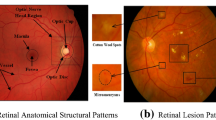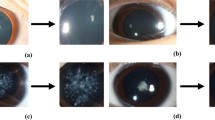Abstract
The automatic retinal screening system (ARSS) is a valuable computer-aided diagnosis tool for healthcare providers and public health initiatives. The ARSS facilitates mass retinal screenings that analyse retinal images and detect early signs of vision-threatening retinal diseases. The degradation in retinal image’s naturalness causes imprecise diagnosis. This paper proposed a quality assessment method that is suitable for ARSS and is important for closing care gaps and reducing healthcare costs in the field of healthcare. A no-reference (NR) quality assessment method utilizing natural scene statistics (NSS) and the multi-resolution approach is developed to detect retinal image quality. Image quality classification is performed combining NSS features and statistical featurenns of retinal image. A support vector machine classifier is used to map the retinal image features and find image quality. The proposed method is compared with existing NR image quality assessment methods. The results show that the proposed method has improved accuracy, recall, precision and F-measure values of 3.42%, 3.66%, 1.63% and 2.66%, respectively, over the competing methods, demonstrating its suitability for ARSS.













Similar content being viewed by others
Data availability
Data sharing not applicable to this article as no datasets were generated or analyzed during the current study.
References
Guo T, Liang Z, Gu Y, Liu K, Xu X, Yang J, Yu Q (2023) Learning for retinal image quality assessment with label regularization. Comput Methods Programs Biomed 228:107238
Vashist P, Senjam SS, Gupta V, Gupta N, Shamanna BR, Wadhwani M, ..., Bharadwaj A (2022) Blindness and visual impairment and their causes in India: results of a nationally representative survey. PLoS One 17(7):e0271736
Sheikh HR, Bovik AC (2006) Image information and visual quality. IEEE Trans Image Process 15(2):430–444
Sahu S, Singh HV, Kumar B, Singh AK (2019) De-noising of ultrasound image using Bayesian approached heavy-tailed Cauchy distribution. Multimed Tools Appl 78:4089–4106
Abdel-Hamid L, El-Rafei A, Michelson G (2017) No-reference quality index for color retinal images. Comput Biol Med 90:68–75
Stępień I, Oszust M (2022) A brief survey on no-reference image quality assessment methods for magnetic resonance images. J Imaging 8(6):160
Chow LS, Rajagopal H (2017) Modified-BRISQUE as no reference image quality assessment for structural MR images. Magn Reson Imaging 43:74–87
Ou FZ, Wang YG, Zhu G (2019) A novel blind image quality assessment method based on refined natural scene statistics. In: 2019 IEEE international conference on image processing (ICIP). Taipei, Taiwan, pp 1004–1008. https://doi.org/10.1109/ICIP.2019.8803047
Niemeijer M, Abramoff MD, van Ginneken B (2006) Image structure clustering for image quality verification of color retina images in diabetic retinopathy screening. Med Image Anal 10(6):888–898
MacGillivray TJ, Cameron JR, Zhang Q, El-Medany A, Mulholland C, Sheng Z, ..., UK Biobank Eye and Vision Consortium (2015) Suitability of UK Biobank retinal images for automatic analysis of morphometric properties of the vasculature. PLoS One 10(5):e0127914
Xu Z, Zou B, Liu Q (2023) A deep retinal image quality assessment network with salient structure priors. Multimed Tools Appl 82(22):34005–34028. https://doi.org/10.1007/s11042-023-14805-3
Raj A, Shah NA, Tiwari AK, Martini MG (2020) Multivariate regression-based convolutional neural network model for fundus image quality assessment. IEEE Access 8:57810–57821
Fu H et al (2019) Evaluation of Retinal Image Quality Assessment Networks in Different Color-Spaces. In: Shen D et al (eds) Medical Image Computing and Computer Assisted Intervention – MICCAI 2019. MICCAI 2019. Lecture Notes in Computer Science, vol 11764. Springer, Cham. https://doi.org/10.1007/978-3-030-32239-7_6
Wang S, Jin K, Lu H, Cheng C, Ye J, Qian D (2015) Human visual system-based fundus image quality assessment of portable fundus camera photographs. IEEE Trans Med Imaging 35(4):1046–1055
Yulianti T, Septama HD, Himayani R, Nugroho HA, Setiawan NA (2022) No reference image quality assessment of retinal image for diabetic retinopathy detection based on feature extraction. AIP conference proceedings, vol 2563. p 080009. https://doi.org/10.1063/5.0103286
Nugroho HA, Yulianti T, Setiawan NA, Dharmawan DA (2014) Contrast measurement for no-reference retinal image quality assessment. 2014 6th International Conference on Information Technology and Electrical Engineering (ICITEE), vol 2014. Yogyakarta, Indonesia, pp 1–4. https://doi.org/10.1109/ICITEED.2014.7007902
Köhler T, Budai A, Kraus MF, Odstrčilik J, Michelson G, Hornegger J (2013) Automatic no-reference quality assessment for retinal fundus images using vessel segmentation. Proceedings of the 26th IEEE international symposium on computer-based medical systems, vol 2013. Porto, Portugal, pp 95–100. https://doi.org/10.1109/CBMS.2013.6627771
Abdel-Hamid L, El-Rafei A, El-Ramly S, Michelson G, Hornegger J (2016) Retinal image quality assessment based on image clarity and content. J Biomed Opt 21(9):096007–096007
Zago GT, Andreao RV, Dorizzi B, Salles EOT (2018) Retinal image quality assessment using deep learning. Comput Biol Med 103:64–70
Abdel-Hamid L (2021) Retinal image quality assessment using transfer learning: spatial images vs. wavelet detail subbands. Ain Shams Eng J 12(3):2799–2807
Hamid LA, El-Rafei A, El-Ramly S, Michelson G, Hornegger J (2015) No-reference wavelet based retinal image quality assessment. In: Computational vision and medical image processing V: proceedings of the 5th eccomas thematic conference on computational vision and medical image processing (VipIMAGE), Spain. pp 123
Sahu S, Singh AK (2023) Genetic algorithm based multi-resolution approach for de-speckling OCT image. Multimed Tools Appl 83:1–22. https://doi.org/10.1007/s11042-023-16575-4
Jha CK, Kolekar MH (2020) Cardiac arrhythmia classification using tunable Q-wavelet transform based features and support vector machine classifier. Biomed Signal Process Control 59:101875
Retina image bank: a project from the American society of Retina specialists. http://imagebank.asrs.org/about. Accessed 30 June 2023
König M, Seeböck P, Gerendas BS, Mylonas G, Winklhofer R, Dimakopoulou I, Schmidt-Erfurth UM (2024) Quality assessment of colour fundus and fluorescein angiography images using deep learning. Br J Ophthalmol 108:98–104
Funding
The authors state that this work has not received any funding.
Author information
Authors and Affiliations
Corresponding author
Ethics declarations
Conflict of interest
The authors of this manuscript declare no conflicts of interest.
Additional information
Publisher's Note
Springer Nature remains neutral with regard to jurisdictional claims in published maps and institutional affiliations.
Rights and permissions
Springer Nature or its licensor (e.g. a society or other partner) holds exclusive rights to this article under a publishing agreement with the author(s) or other rightsholder(s); author self-archiving of the accepted manuscript version of this article is solely governed by the terms of such publishing agreement and applicable law.
About this article
Cite this article
Sahu, S., Singh, A. & Priyadarshini, N. No reference retinal image quality assessment using support vector machine classifier in wavelet domain. Multimed Tools Appl (2024). https://doi.org/10.1007/s11042-024-19207-7
Received:
Revised:
Accepted:
Published:
DOI: https://doi.org/10.1007/s11042-024-19207-7




